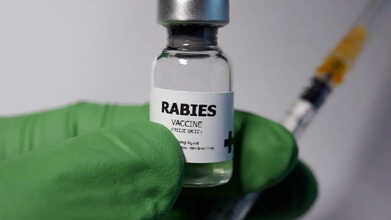- Health Conditions A-Z
- Health & Wellness
- Nutrition
- Fitness
- Health News
- Ayurveda
- Videos
- Medicine A-Z
- Parenting
Measles Outbreak: 1 Person Can Infect Up To 18 People, It Is Highly Contagious, Says CDC

Credits: Canva
Measles is spreading across continents now. For now it had spread in Texas and New Mexico, now Australia too has reported surge of the same infectious disease. The disease is highly contagious, even more than Ebola, smallpox or any other disease you may have heard of. One sick person can infect up to 18 people with measles. Whereas the number of people who can be infected from one person in other infectious disease is low. For instance, if one person is sick with Ebola, he can at maximum infect two people, for COVID-19, it is three people; for HIV, SARS, the number is four. Diseases like chickenpox and mumps have greater number, 12 and 14 people respectively, however, the highest number of people who can be infected by a disease from one person is measles, as per The Lancet, University of Michigan School of Public Health and Journal of Theoretical Biology's data.
Highly Infectious, Highly Lethal
Before the invention of vaccination, which helped eliminate the disease in the US, almost everyone in childhood got measles. Not only that, but, 400 to 500 children had also died from the same each year. However, it was the vaccination that was able to beat the measles outbreak. The concern now is the drop in vaccination rates, which could beat back the elimination of the disease from the United States.
How Does It Spread?
Scientists use a concept called reproduction manner or the R naught to see who quickly a disease spreads. This is also the number of people, on average, that a single infected person can transmit a disease to.
For measles, the R naught is 12 to 18, which is higher than with other infectious disease. However, it is still a theoretical number and like Justin Lessler, an epidemiologist at the University of North Carolina Gillings School of Global Public Health says, "It is not some magical constant."
This concept assumes that no one has immunity to a given disease, this is what the "naught" refers to, which means zero. It helps scientists compare the infectious potential of different diseases, however, the concept may differ depending on various factors, including how easily measles of any other disease transmits and alters the process.
ALSO READ: Measles FAQs: What You Must Know About The Disease
Then comes the concept of effective reproduction number. This is the number of people that a sick person can infect in a given population at any specific time. This changes as more people become immune through infection or vaccination. This also changes based on how people react or behave towards a new infectious disease? Do the isolate? Do they cluster together and socialize? These scenarios can then give an opportunity for the virus to exist. Thus this concept depends on how the community reacts to deal with the virus.
The Power Of Vaccines
However, all of this could be beaten with the help of vaccination. Depending on the vaccination rate, one person can infect around 12 to 18 people in case there has been 0% vaccination. If 67% of the population is vaccinated, only 5% people would be infected. If 82% of the population is vaccinated, only 2 to 3 people would be infected. Lastly, the Centers for Disease Control and Prevention (CDC) also notes that if 95% of the population is vaccinated, there will be fewer than one case of measles.
READ MORE: Measles Outbreak Cases Cross 100 Mark In US, Australia Sees Sudden Surge Of The Infectious Disease
Wegovy Starter Dose Now Available As Daily Pill, Replacing Weekly Injections

Credits: Canva
Americans can now buy the starter dose of the widely used weight loss drug Wegovy in pill form. The announcement was made on Monday by drugmaker Novo Nordisk. Higher strengths of the medication are expected to be rolled out as pills by the end of the week.
Wegovy Pill: How Much The Pill Costs Compared To Injections
The once-a-day pill is available with a prescription and is generally cheaper than the weekly injection for people paying out of pocket. This applies to patients who choose to purchase the drug directly from Novo Nordisk and do not use insurance. Until now, Wegovy’s high price had kept it out of reach for many people trying to lose weight, especially since most private insurance plans do not cover obesity treatment.
The oral starter dose of 1.5 mg costs $149 per month for cash-paying patients. This pricing follows a recent agreement between Novo Nordisk and the Trump administration. The 4 mg pill is priced the same until April 15, after which it will rise to $199 per month. Higher doses come at a steeper cost. The 9 mg and 25 mg pills are priced at $299 a month, according to the company.
By comparison, the injectable version of Wegovy costs $349 per month for people paying without insurance. However, new users can access two months of the lowest two injection doses at $199 each until March, Novo Nordisk says.
Wegovy Pill: What Insured Patients May Pay
As per CNN, Patients whose insurance plans do cover Wegovy for obesity may pay as little as $25 a month for either the pill or the injection through a savings programme offered by the company. The pill can be obtained through pharmacies, selected telehealth platforms, NovoCare Pharmacy, and other approved outlets.
Wegovy is also approved to lower the risk of heart attack, stroke, and death in adults who are overweight or obese and already have heart disease.
Wegovy Pill: FDA Approval And How The Pill Performs
The US Food and Drug Administration approved the daily pill version of Wegovy in late December. According to Novo Nordisk, clinical trials showed that the pill led to weight loss and side effects that were broadly similar to those seen with the injectable form.
Like the injection, the pill contains semaglutide. This is the same active ingredient used in Wegovy’s diabetes counterpart, Ozempic.
Wegovy Pill: Competition from Eli Lilly
Rival drugmaker Eli Lilly is also working on an oral GLP-1 medication. The drug, currently known as orforglipron, is still awaiting a brand name. It is expected to receive FDA approval by summer and will also launch with a $149 starting price under the same Trump administration agreement. Higher doses of orforglipron could cost up to $399 a month for patients paying cash, as per CNN.
Wegovy Pills Are More Effective
The Wegovy pill and Lilly’s orforglipron have not been directly compared in a single clinical trial. However, results from separate studies give some insight. The Wegovy pill led to an average weight loss of 14 percent over 64 weeks, compared with 2 percent in people taking a placebo. Orforglipron showed an average weight loss of 11 percent over 72 weeks at its highest dose, also compared with 2 percent for placebo.
In trials of injectable versions, Wegovy resulted in about 15 percent weight loss, versus 2 percent for placebo. Lilly’s Zepbound showed even higher results, with 21 percent weight loss at its highest dose, compared with 3 percent for placebo.
Wegovy Pill Side Effects And Dropouts
Digestive problems such as nausea and vomiting remain the most common side effects of GLP-1 drugs. These issues were also reported in studies of the pill versions. Around 7 percent of participants taking the Wegovy pill stopped treatment because of side effects, compared with 6 percent in the placebo group. In orforglipron’s trial, up to 10 percent of patients discontinued treatment, compared with 3 percent on placebo.
One key difference lies in how the medications are used. The Wegovy pill must be taken on an empty stomach with a small amount of water. Patients are advised not to eat, drink, or take other medicines for at least 30 minutes afterward. Doctors say this requirement has limited the use of Rybelsus, the pill form of semaglutide approved for diabetes, compared with Ozempic.
Eli Lilly highlights that orforglipron was taken once daily in trials without restrictions on food or water, which may make it easier for patients to use consistently.
Delhi Government To Declare Human Rabies A Notifiable Disease: What Does This Mean?

Credits: Canva
The Delhi government is set to notify human rabies as a notifiable disease in the National Capital Territory under the Epidemic Diseases Act, Health Minister Pankaj Kumar announced on Sunday. The step is aimed at improving disease monitoring, ensuring faster reporting of cases, and allowing authorities to act quickly to curb the spread of rabies.
According to the minister, once the notification comes into force, all government and private healthcare facilities, including medical colleges and individual doctors, will be legally required to report suspected, probable, and confirmed human rabies cases to the relevant health departments. Kumar stressed that rabies is “nearly 100 per cent fatal once symptoms begin,” but added that it can be fully prevented if medical care is sought on time. “Timely reporting is critical. It can save lives and help stop further transmission,” he said.
What Is Rabies?
Rabies is a life-threatening viral disease that can be prevented through vaccination. It affects the central nervous system and leads to severe inflammation of the brain, known as encephalitis. The infection spreads mainly through the bite or scratch of an infected animal, as the virus is present in saliva. According to the World Health Organization, rabies is almost always fatal after symptoms develop. Early signs may resemble flu, but the disease can progress to agitation, paralysis, and hydrophobia, or fear of water.
What Is A Notifiable Disease?
A notifiable disease is one that must be reported to public health authorities by law when a case is diagnosed or even suspected. This reporting system allows health officials to track diseases in real time, respond quickly, and plan interventions based on reliable data. In India, this approach has already been used for illnesses such as tuberculosis and COVID-19 to identify trends and manage resources more effectively.
Rabies To Be Declared A Notifiable Disease
With human rabies set to be classified as a notifiable disease in Delhi under the Epidemic Diseases Act, all healthcare institutions will be required to inform authorities immediately when a case is identified. This move is expected to strengthen the Integrated Disease Surveillance Programme (IDSP), the country’s main disease monitoring system, enabling officials to detect cases early and take prompt action to prevent wider spread.
What Are The Symptoms Of Rabies?
According to the Mayo Clinic, early symptoms of rabies can closely resemble those of the flu and may persist for several days.
Later symptoms can include:
- Fever
- Headache
- Nausea
- Vomiting
- Agitation
- Anxiety
- Confusion
- Hyperactivity
- Difficulty swallowing
- Excessive salivation
- Fear triggered by attempts to drink fluids due to difficulty swallowing water
- Fear triggered by air blown on the face
- Hallucinations
- Insomnia
- Partial paralysis
Why Does Rabies Surveillance Matter?
Rabies continues to pose a serious public health challenge in India and across the world.
- Once clinical symptoms appear, rabies is almost always fatal, making early detection and reporting crucial.
- The WHO estimates that rabies causes around 59,000 human deaths every year worldwide, with dog bites responsible for nearly 99 per cent of infections.
- India alone accounts for an estimated 18,000 to 20,000 rabies deaths annually, with a significant number of cases seen in children under the age of 15.
Although rabies is completely preventable through timely post-exposure prophylaxis, which includes proper wound cleaning, vaccination, and the use of rabies immunoglobulin, poor reporting and limited access to care have remained major obstacles.
Declaring human rabies a notifiable disease in Delhi signals an important change in public health policy, one that has the potential to greatly improve how cases are identified, managed, and ultimately prevented.
US Doctors Name 2025 As The Worst Year For MMR Vaccination Rates As Measles Continues To Spread

US Doctors Name 2025 As The Worst Year For MMR Vaccination Rates As Measles Continues To Spread
The US Centers for Disease Control and Prevention is asking parents across the country to ensure their children have received both doses of the measles, mumps, rubella (MMR) vaccine as cases continue to surge for the first time in three decades.
As of December 30, three people have died and 2,065 Americans have been found suffering from the life-threatening illness. Officials say this is the largest outbreak since 2,126 cases were last reported in 1992 and warn that the case count will continue to grow through January.
While the initial outbreak was reported in a small religious community in Texas, the disease quickly spread throughout the country and is currently affecting children and teenagers in Alabama, Alaska, Arizona, Arkansas, California, Colorado, Connecticut, Florida, Georgia, Hawaii, Idaho, Illinois, Indiana, Iowa, Kansas, Kentucky, Louisiana, Maryland, Michigan, Minnesota, Missouri, Montana, Nebraska, Nevada, New Jersey, New Mexico, New York City, New York State, North Dakota, Ohio, Oklahoma, Oregon, Pennsylvania, Rhode Island, South Carolina, South Dakota, Tennessee, Texas, Utah, Vermont, Virginia, Washington, Wisconsin and Wyoming, according to the CDC.
The federal agency also noted that out of the cases reported, 865 patients were between the ages of five to 19 while 650 were over the age of 20. Apart from this, 537 people were below the age of five while the ages of the remaining 13 were unknown.
Only three percent of the cases have received their first dose of the MMR vaccine while merely four percent completed both doses. It remains unclear whether 93 percent of people have received any doses of the vaccine.
Dr Linda Bell, South Carolina’s state epidemiologist, noted at a press briefing last week that one of the primary reasons for the rampant spread of the disease have been family gatherings during this holiday season and cross-country travel.
Measles: The World's Most Infectious Disease
Measles is a highly contagious illness that can cause widespread rashes and flu-like symptoms such as high fever, cough, red spots, bloodshot eyes, muscle pain and headaches. If left untreated, the disease can lead to life-threatening complications like brain inflammation and pneumonia.
The virus is spread through direct contact with infectious droplets or through the air that can linger in the air for up to two hours. Patients with a measles infection are contagious from four days before the rash through four days after the rash appears.
Without immunity from a vaccine or prior infection, about 9 in 10 people exposed to measles will be infected. About one in five unvaccinated people are hospitalized and three in 1,000 people who contract the disease are expected to die.
READ MORE: US Measles Cases Surge Past 2,000, Putting Elimination Status At Risk
Falling Vaccination Rates of Measles
Despite being deadly, the illness can be prevented through vaccination. The CDC says a single dose of the MMR vaccine is about 93 percent effective at preventing measles, while two doses increase protection to 97 percent.
However, immunization coverage has seen a stark decline in the last few years. While the nationwide MMR vaccination rate is 92.5 percent, merely 79.6 percent of of kindergartners were vaccinated for the 2023-2024 school year.
Additionally, only 84.3 percent of school children were vaccinated in Alaska while Hawaii, Ohio , Georgia, Oklahoma and Arizona saw a vaccination rate of about 89 percent, CDC data shows.
According to a John Hopkins University study, 2025 was noted to be the worst year for MMR immunization coverage as the nationwide average saw a decline of 2.67 percent of vaccination rates among US children since the 2020.
James Colgrove, a professor at Columbia University Mailman School of Public Health told The Washington Post, "The most dangerous deadly diseases will come back and it won’t only be kids who suffer. It’ll be adults in the community who are immune-compromised, who are elderly. It’ll be infants."
© 2024 Bennett, Coleman & Company Limited

